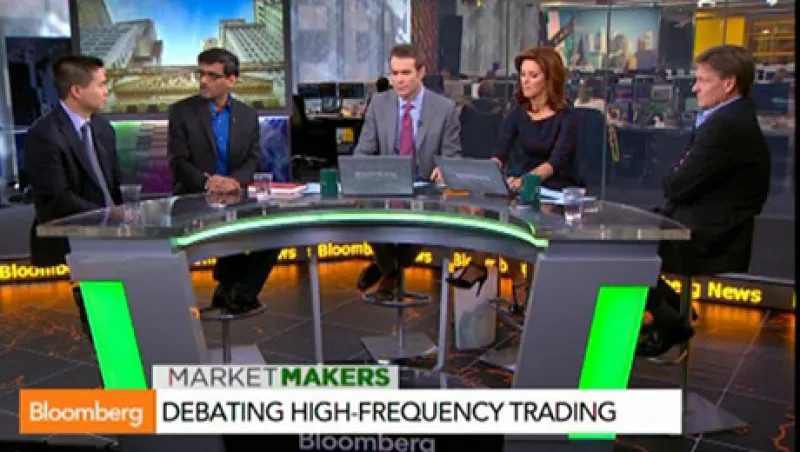As I remarked during my debate with Michael Lewis on Bloomberg TV last week, I hold a dim view of his latest work, Flash Boys: A Wall Street Revolt; to me it is fiction masquerading as journalistic exposé.
In his Orwellian narrative, the small, entrepreneurial firms that upended the status quo on Wall Street by using computers to automate the jobs of inefficient fat-cat market insiders are the bad guys, and incredibly, the fat cats themselves are the good guys. Yes, that’s correct, the upstarts who leveled the playing field and who made stock trading far cheaper for investors big and small — these are the villains; and the disgruntled guys who used to feed at the trough of the two-tiered market are the heroes. In the greatest of absurdities, Goldman Sachs is one of the protagonist-victims of Michael Lewis’s novel.
His nostalgia for the heady days of Liar’s Poker has clearly messed with Lewis’s ability to see things clearly, and has exposed him as nothing more than a cheerleader for Wall Street who clearly misses the fun and glory of the trading floor during its years of excess when he was a trainee at Salomon Brothers. There is, in fact, very little that he gets right in this novel. (See also “Ringside at the Michael Lewis High-Frequency-Trading Big Top.”)
The most annoying and harmful message in Lewis’s fictional account of the markets is that they are somehow “rigged.” As evidence for this, conspiracy theorists have lately pointed their collective whistles and blown them at the fact that the large high frequency trading firm Virtu Financial disclosed in a regulatory filing that it has operated for multiple years with only a single losing day. This is taken to mean that HFT firms are not committing capital or taking risk. Instead, they are “skimming” risklessly off of every transaction like parasitic leeches.
To the people who make these bombastic claims, it is impossible to reconcile the fact that a very stable business can be built even though risk is taken on every single transaction. Allow me to explain. My firm is a mid-sized HFT firm that regularly trades over 1 percent of the daily market volume of the U.S. equity market. Our winning percentage, on a per-trade basis, is in the low 50s — in other words, barely better than a coin flip. That means we lose money on nearly half our trades. Does this sound like risk is being taken? We sure think it does!
However, because we make many trades per day, our daily winning percentage for the past four years is around 86 percent. How is that possible? It’s not my place to explain basic probability and statistics in this article, but here’s a hint for people who are confused by this: look at the Wikipedia article on the Law of Large Numbers, or read an introductory textbook on finance and learn about how diversification works.
Now, this is not quite the money machine that Virtu’s business is, but guess what: If you took three independent firms of the same size and scale as mine, and combined them, you’d have a daily winning percentage in excess of 99 percent, without doing anything extra at all. Here’s another way to state the same thing: If you look at how many winning weeks my firm has had, it is over 99 percent — all with a per-trade winning percentage barely north of 50 percent — funny how math works.
While I’m still in the mood to disclose all kinds of confidential information about my firm’s trading strategies, here is another tasty tidbit. The average profit my firm makes from its HFT strategies is about 5 cents per 100 shares executed. So, here’s an interesting and informative scenario: suppose a client of Chuck Schwab submitted a 200-share order, and that somehow, that order ultimately got routed to a stock exchange, where it was filled by my firm. Based on the economics I just disclosed, I would expect to make a measly 10 cents on this 200-share transaction. And that is not even guaranteed. There is a nearly 50 percent chance I’d lose money. By contrast, do you know what Chuck’s firm earned on that same exact transaction? Nine dollars, guaranteed. That is 90 times higher than what my firm made on the exact same transaction. And all he did is risklessly route his client’s order to the exchange so that I could risk my capital by taking the other side of the trade. And for this, I get to be treated to Schwab’s comments in the press last week about how HFT is a “growing cancer” that has “undermined fairness.” Is risklessly routing a client’s order really worth 90 times as much in compensation as providing liquidity to the client by taking the other side of the order? And why is nobody complaining that Schwab is making money 100 percent of every hour of every day, without risking any capital?
Schwab’s statements are a perversion of reality. Because HFT firms use computers rather than overpaid human traders to provide liquidity, they have revolutionized the business of trading stocks and brought massive benefits to society in the form of lower trading costs. The asset management industry (hedge funds, mutual funds and exchange-traded funds) in the U.S. has swelled to record sizes on the back of this cheap liquidity. In the meantime, Schwab’s commissions have barely budged over this period.
Claims of rigging aside, Michael Lewis’s book is, at its core, a diatribe about the importance of speed in the markets. Since the advent of markets, speed has always mattered. But the fact is, speed matters less today than it ever has, and we largely have HFT to thank for that. This statement may come as a shock to people, but the fact is that the technology revolution that has come to be known pejoratively as the “HFT arms race” is pretty much in its final throes. Latency (the time it takes to execute a trade from the moment it is placed) is as close to zero as it’s going to get, and the techniques that high frequency traders pioneered are now widely deployed by brokerage firms that handle client orders. As a result, the speed differentials between fast and slow players are now measured in microseconds or nanoseconds, whereas ten or 20 years ago they were measured in seconds or minutes. It ought to be clear to any logical person that if zero difference between players represents total fairness, then the closer such differences are to zero, the closer you are to total fairness. Such is the state of affairs today, and it is because HFT firms have pushed the state of the art as close to zero as possible.
As a practical matter, speed advantages are not static, they have a large amount of random variation around the average. Thus, the smaller a speed edge gets, the less deterministic it is, and the harder it is to monetize. In practice, a one-second average latency advantage means that your order will beat a competitor’s every time, but a one-nanosecond average advantage means that your competitor will beat you roughly half the time. In other words, the smaller the speed advantage, the less of an economic benefit it confers. This is not to say that speed does not matter — it still does, and it always will. However, it does follow that speed matters less today than it ever has, and we largely have the HFT revolution to thank for that.
Of all the sources of speed advantage, it is ironic that colocation has come in for the greatest criticism. It is true that proximity to the centers of price discovery has always been important for trading. But it is also true that people used to have to pay millions of dollars to obtain maximum proximity (or “local” status), and that there was a small finite supply of seats available on the exchange. Now, by contrast, for as little as $1,000 a month, anybody who wishes can obtain the modern equivalent of a seat on the exchange and have all the advantages of proximity that yesterday’s insiders used to possess.
Colocation represents the ultimate ideal in fairness when it comes to proximity, and we have high frequency traders to thank for this innovation. In fact, Dave Cummings of the pioneering HFT firm Tradebot deserves special recognition for inventing this concept nearly a decade ago.
One of the principal advantages conferred by colocation is the ability to consume the direct feeds of the exchanges without paying for expensive long-distance telecommunications to transport it. But these feeds have themselves been the subject of major controversy, with detractors arguing that they should be banned because they are faster than the consolidated feeds (known as SIPs) that are mandated to exist by regulation. I and many others agree that this speed discrepancy is problematic, but banning the direct feeds is the wrong solution. A far more straightforward solution exists, namely, to compel the exchanges to modernize the highly antiquated SIPs. Why is it that the detractors always want us to move backward instead of forward? It is not the case that the direct feeds offer a speed advantage that must be curtailed; the reality is that the SIPs confer a disadvantage that ought to be mitigated. You can not ban the direct feeds — they represent the true current state of the market, and there is no other source of information about the full depth of the order book for each exchange. However, you can make the SIP faster. How about opting for the easy and obvious solutions first, people?
Even worse, Flash Boys buys into the hyperbolic notion that having direct feeds allows one to “legally front-run” ordinary traders. This demonstrates sheer ignorance of how the market works. The fact is, the moment a quote appears on a direct feed, that is a reflection of the fact that the corresponding order has already been accepted into the order book of the exchange. Once that order is displayed in the book, there is no way for any other order to jump in front of it. Anybody who thinks otherwise is extremely confused, and also mistaken.
And what of this magical term “latency arbitrage”? I call it magical because it has a habit of changing its meaning every time somebody seeks to debunk it, making it virtually immune to destruction, like a rapidly mutating virus. I can think of at least three definitions it’s taken on in the past — one related to dark pools pegging their orders to a stale price, another related to an artifact of how slower matching engines convey information about executions and another vague meaning that aims to be a catch-all for any putative ill effect of the speed advantage of direct feeds over consolidated feeds.
One of the more stupid contentions regarding latency arbitrage is that it allows its beneficiaries to see the future. Perhaps, but only if your brain has been addled by too much time travel. You see, the SIP does not reflect the current state of the market, it is delayed. The direct feeds are the most current reflection of the state of the order book. It is in fact true that the present allows you to predict the past, much in the same way that the SIP allows you to predict the 20-minute delayed quotes you can get for free over the Internet. However, it must be said that neither activity entails any economic benefit, because you can’t make money by predicting the past.
It is worth noting that no matter how hard they try, regulators and policy makers cannot eliminate speed advantages in the market. They can, and should, eliminate unfair advantages, such as private or commercial data offerings that are not available on an equitable basis. For example, I believe that it is correct for the government to crack down on early releases of government data, or analyst recommendations. In my view, government data should be subject to rules similar to Reg FD (Fair Disclosure) that governs the dissemination of corporate announcements.
However, direct data feeds are not even remotely in the same category. They are in very widespread use, and they contain information which is necessary for certain players in the market to have, namely the full depth of the order book, which is not contained in the SIP.
What if regulators forced exchanges to deliver their direct feeds for free? Believe it or not, this used to be the case for several exchanges not long ago. Would this result in an elimination of the speed advantage of having direct feeds? Not even close. The reason is that a tremendous amount of skill is required to process this information and use it to generate trading signals. People who can do it faster will be rewarded, and there is not a thing regulators can do about this. Nor should they seek to. When you are taking an exam, speed and correctness both count. The same thing applies in the market.
The conspiracy theorists and self-anointed whistle-blowers of the world will use my remarks to conclude that I am an apologist for the current market structure, and that I am an advocate of the status quo in the stock market. This could not be further from the truth. Like them, I think the market is far too complex and far too fragmented. However, unlike them, I actually understand what is broken and how it should be fixed. Another bout of regulatory upheaval of the sort we had in 2007 is not the answer. The principal beneficiaries of that last upheaval were HFT firms, and the same thing will be true a second time around. Instead, I offer the following relatively modest yet efficacious proposals:
Reform the SIP. Reliability is important, but closing the speed gap versus the direct feeds is even more important. Countless conspiracy theories about the market exist solely because of this discrepancy, resulting in the erosion of investor confidence. It’s overdue that this gap be closed to the maximum extent possible.
Reform the order protection rule. The ban on locked markets in Rule 611 of Reg NMS is extremely harmful to the market, and is the principal source of all the unnecessary complexity with which we are faced. If it were lifted, quote stuffing would virtually disappear, the need for speedy routes between market centers would be dramatically curtailed, exotic order types would be completely and utterly useless, the rules of trading would be massively simplified and understandable again by the majority of people, spreads would tighten, and volume would return to the lit markets from dark pools. Even payment for order flow would come under pressure. In other words, virtually every negative aspect of today’s markets would be ameliorated or outright cured. The reasons are complex but straightforward, and I’ve written on them for Institutional Investor previously. If there is demand from readers, I am happy to proffer a more detailed explanation.
Reform tiered rebates. It is flat-out unfair that exchanges are allowed to offer higher rebates to large traders than to small traders. I say this as someone who benefits from the highest tier of rebates at every exchange, so I’m not talking my book. There should be one rate for everyone, that’s what is fair.
Examine retail brokerage commissions and practices. Brokerage commissions for institutional investors have plummeted by an order of magnitude since the advent of HFT. However, retail investors are still paying basically the same thing as they were in 2007. What’s the deal with that, Chuck Schwab? How about passing on some of your savings to the little guy? And while we’re at it, the fairness of paying brokers for their order flow should be revisited.
Manoj Narang is the founder and CEO of Tradeworx.






